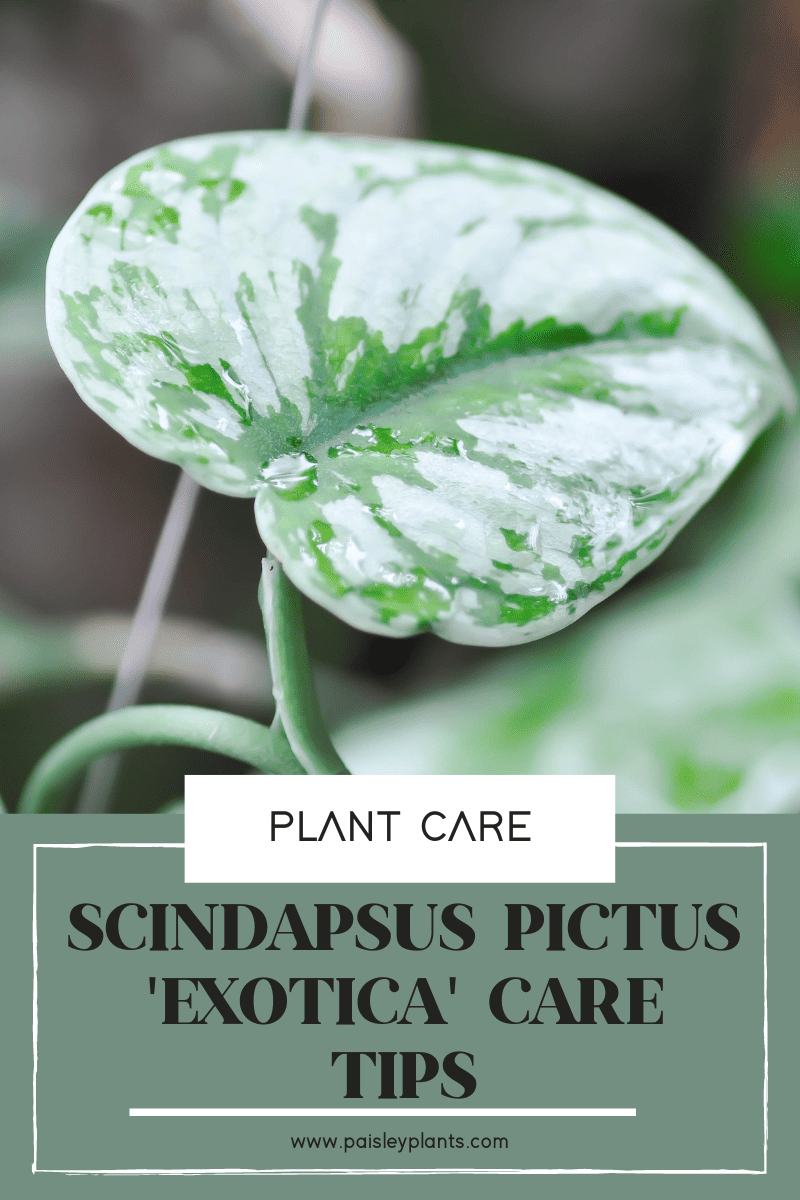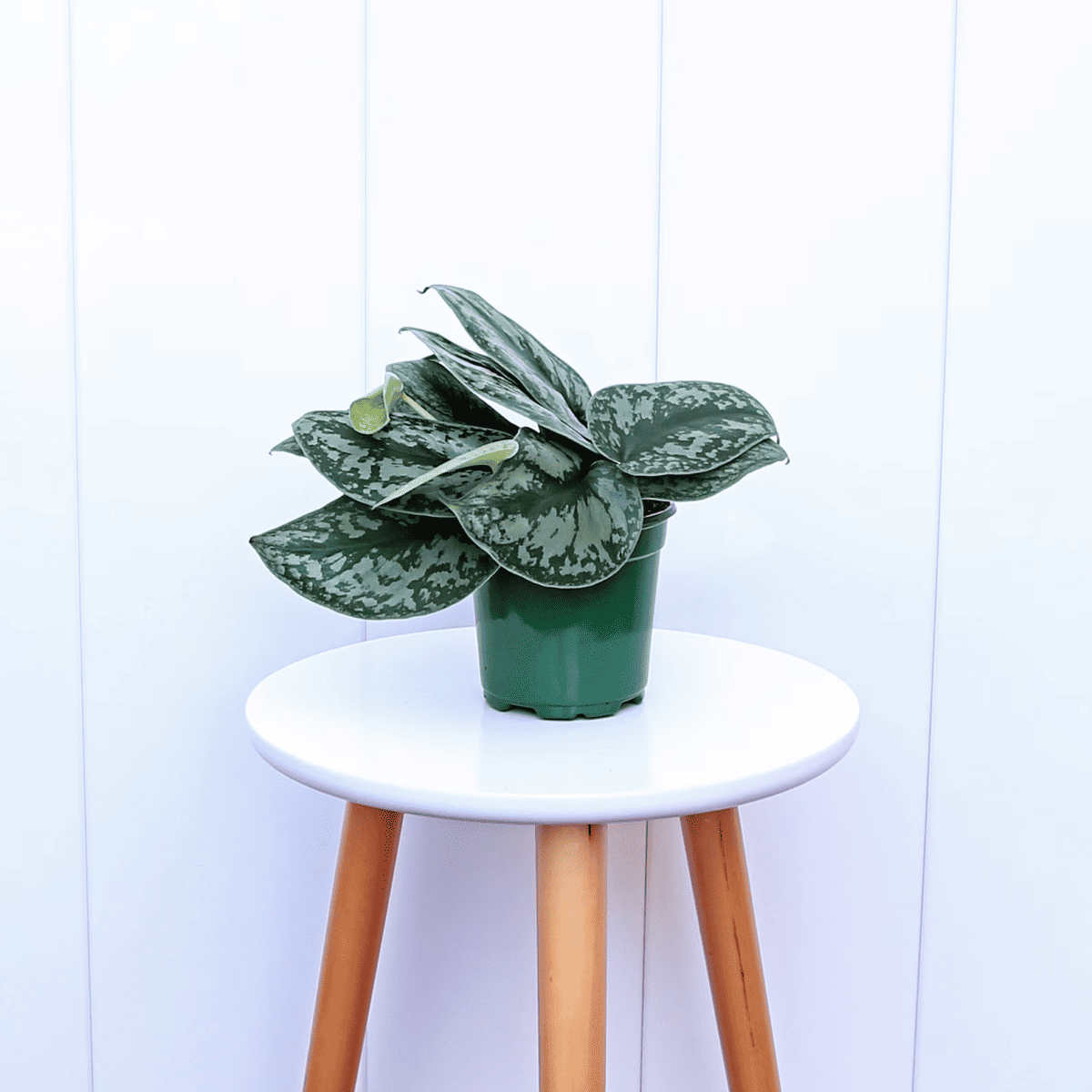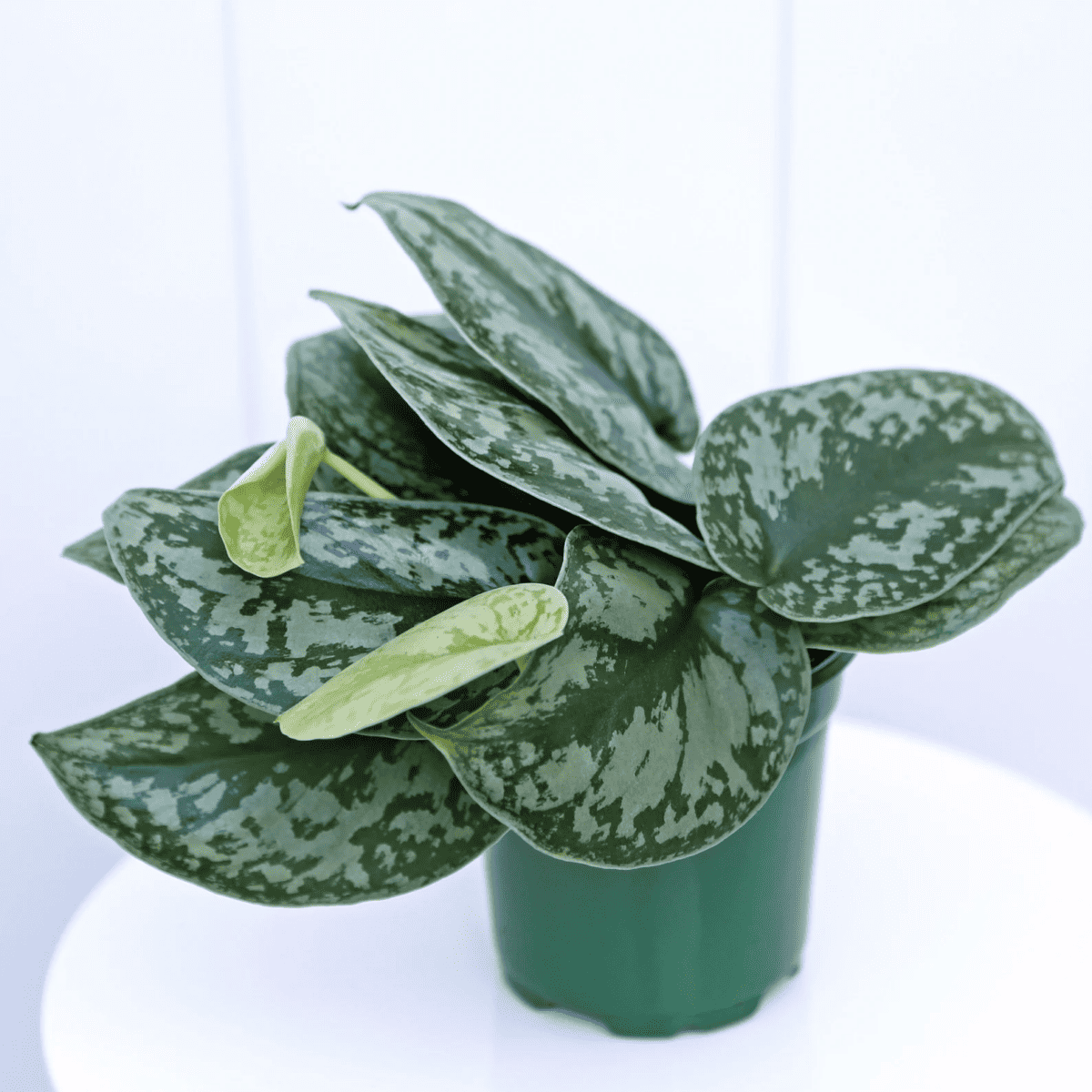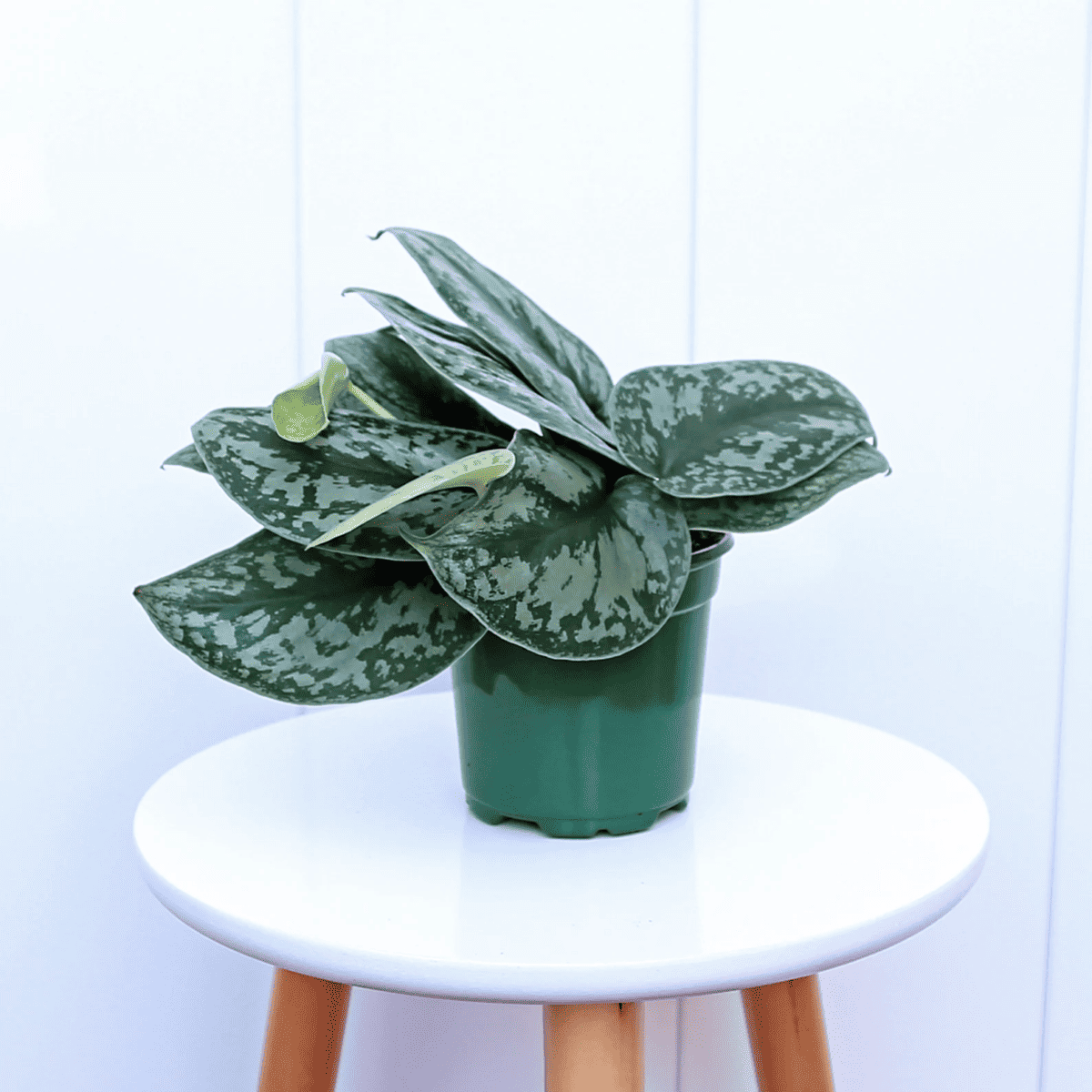The Scindapsus Pictus ‘Exotica’ plant is a sweet looking heart shaped leaf plant that would be a good one for beginners or experienced plant parents to grow.
It is a vigorous vining plant whose green foliage is speckled with silvery, reflective variegation and lights up any room!

Table of Contents
Scindapsus Pictus ‘Exotica’ Background/History
These interesting tropical plants are native to warm and humid regions of Sumatra, the Philippines, Bangladesh, Sulawesi, Thailand, Peninsular Malaysia, Borneo and Java. It grows as an epiphyte, which means it’s a plant that gets its moisture from the air and rain and usually grows on another plant in it’s natural habitat!
The heart shaped leaves on the Scindapsus Pictus ‘Exotica’ are velvety to the touch and are quite matte in nature (not shiny). This plant will climb as a vine if it is placed on a moss pole or even a trellis. Since it is quite slow growing, it won’t take up much room wherever you place it.
It is considered a shingling species because as it grows upwards, the leaves grow flat against whatever surface they are climbing on. They thus resemble shingles on a roof!
Common Names
It is commonly known as a Silver Philodendron, Satin Pothos, Silver Pothos or Silver Satin Pothos, but technically is neither a philodendron or a pothos! Sometimes this gorgeous trailing plant is also referred to as a Silver Splash Pothos or a Silver vine.
This one also isn’t a true Satin Pothos which is a Scindapsus Pictus ‘Argyraeus’.
Varieties
From all the information I have been able to gather on the Scindapsus Exotica, it is safe to say this – they are not a philodendron nor are they a pothos. They are often confused with those other two types of plants, but they are not technically either of those even though they look very similar.
There are nine common varieties of the Scindapsus that can be found online if you do some looking. There are even some beautiful prints with detailed pictures of the leaves of the specific types of Scindapsus. All that to say, there are quite a variety of Scindapsus in our world.
Toxicity
This plant is definitely toxic to both humans and animals. You need to be aware of this if you have either young children or pets in your home. They contain calcium oxalate crystals which are microscopically sharp and insoluble chemicals and are toxic if ingested.

Image via Rooted Friends
Scindapsus Exotica Care Tips
Although this plant is a fairly easy plant to grow, here’s some expert tips to have healthy plants for years to come!
Water Requirements
One good thing about the Scindapsus Pictus Exotica is that when it is thirsty, it will tell you! The leaves will begin to curl inward, which is an indication that the plant is getting too dry. You should water your plant once the top 2 to 3 inches of soil is dry.
Be sure to never let the soil dry out completely, however, as this may cause the roots to shrivel and die. Also, you should never keep the soil too moist, or it can lead to root rot, which is another big problem for plants.
During the summer growing season when your plant is actively growing, you may need to water weekly. During the winter growing season when your plant is growing more slowly, you may not need to water as often.
You will need to determine this by checking the moisture in the soil. Keeping a regular watering schedule will go a long way to helping to ensure your plant is healthy and happy!
Light Requirements
Your Scindapsus Pictus ‘Exotica’ will never do well in direct sunlight. This will burn the leaves of your plant. It will, however, do best in several hours a day of bright indirect light. It can also tolerate medium to low light, although it may be more of a slow-growing plant with these types of light conditions.
You will also need to be sure that you rotate your indoor plant on a regular basis. If you don’t, you may begin to see an uneven growth pattern as the leaves growing closest to the light will begin to stretch out and become longer. The ones on the opposite side of the light source will be stunted, which will lead to having a lopsided plant!
If you don’t have ample natural light, you can always use grow lights! Just remember, too much light is just as bad as not enough light for these plants.

Image via Rooted Friends
Soil Requirements
Because this plant is sensitive to root rot, you will want to ensure that you have a soil that is loose and well draining. You want the soil to retain water, but not hold it and become soggy. You need to be sure to have good drainage in the pot your plant is planted in so excess water can get out.
Your Scindapsus Exotica does best in soil that is rich with organic material. Using a combination of equal parts of orchid bark, coco peat, potting soil and perlite makes an excellent soil mixture. This combination will be one that is airy, fertile and moist, but also well draining.
Fertilizer Requirements
You may not necessarily need to fertilize your Exotica, but it sure won’t hurt if you do! Using a good balanced liquid fertilizer during the spring and summer months will definitely benefit the growth of your plant. Once the fall months roll around, you can back off fertilizing your plant as the growth cycle will slow down.
Another thing to remember about your Exotica is that they do typically bloom with flowers in the wild. However, it is very uncommon for them to bloom when grown indoors. So, don’t worry or beat yourself up if your plant never blooms! This is only natural and nothing to worry about!
Temperature and Humidity Requirements
The best temperature range for your Scindapsus Exotica is between 65 and 85 degrees F. This plant is a tropical plant, so this temperature range is best.
You also want to be sure you don’t allow your plant to be kept in temps below 55 degrees F on a regular basis. This won’t help the plant thrive and may cause damage. They will be killed if you allow them to be in temperatures below 32 degrees F.
The humidity levels in a normal household are usually sufficient for your Scindapsus Exotica. A humidity level of around 50 percent is fine for this plant. You can always add humidity if the room you have your plant in is dry, but it is not always necessary.

Image via Rooted Friends
Pests and Diseases
Even though the Scindapsus Pictus ‘Exotica’ is not particularly prone to pests or diseases, you will want to keep an eye out for common pests such as spider mites, mealy bugs, scale insects, thrips, and fungus gnats.
If you do notice any of these pests, you need to first isolate your plant from your other plants. Then, you need to treat the specific pest by using either neem oil or antibacterial soap. You can purchase either of these online or at your local garden center. Follow package instructions to know exactly how to use them.
The most common disease for your Scindapsus Exotica is root rot. This can be prevented easily by not overwatering your plant or allowing it to sit in wet soil. Proper drainage is the best preventative measure you can take to never have to deal with this issue!
Pruning/Repotting
You will always want to prune any dead or yellow leaves off of your Scindapsus Exotica. This will help preserve the energy for the remaining healthy dark green leaves. A healthy plant is a happy plant!
When it comes to repotting your plant, you will want to do this when the roots begin to come through the drainage hole in the bottom of your pot. When you notice this happening, you should find a larger pot (no larger than 1-2 inches than the current one) and place your plant in it.
Be sure to use new, fresh potting mix to do this. You always need to remember that the soil your plant grows in loses its nutrients over time, so new soil is always necessary when you repot your plant.
Common Problems
One common problem is that of dry roots. If your plant’s roots dry up, they can no longer absorb moisture for the leaves of the plant. Be sure to water your plant on a regular basis so that you can ensure a healthy root system, which will then ensure a healthy overall plant.
Yellowing leaves can signal a few types of problems. One can be overwatering. If this is the case, be sure to water your plant when the top of the soil is dry to the touch. Keep your plant watered on a regular watering schedule and this should help prevent any problems.
Keeping your plant in low light conditions is okay, but it also may result in the foliage not being as bright or distinctive in its markings. The Scindapsus is known for its particularly silvery green markings and these will tend to fade if it is kept in low light for too long a time period.
Scindapsus Pictus ‘Exotica’ FAQs
Yes! This is a climbing plant by nature and it is how it grows in the wild. It likes to attach and grow on either trees or will also grow on a moss pole if you use one in your home. This is a perfect plant to have as a climbing plant or in a hanging basket!
If you prune your plant on a regular basis, your plant will spread out and look bushier. You can do this by removing spindly looking stems and using them to propagate new plants. This is a win/win situation either way!
Place your plant in an east or north facing window for the best light conditions. You can also set it in a south or west facing window, but it should be set back a bit so as not to get direct sunlight. Having your plant in direct sunlight will burn the leaves and cause discoloring.
This very hardy, easy to grow plant is a great choice for the beginner grower. You may just want to try growing one to see how you fare as a plant parent. It will make the start to your plant journey an easy one and it may even convince you that you really can do this!
On the other hand, if you are an experienced plant parent, you may already own many of these plants. If that’s the case, you can share your knowledge with the newbies out there and encourage them that this is one of nature’s gifts and is worth trying! As always, keep on growing!
